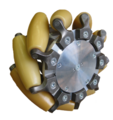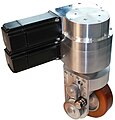Omnidirectional drive
An omnidirectional drive , also known as an omnidrive , is a drive with a special wheel construction that allows a vehicle to travel in any direction at any time. This drive is mostly used in robotics and has been standard for soccer robots for years.
Designs
Omnidirectional wheels
The core of an omnidirectional drive is a so-called all -side wheel or omnidirectional wheel, also called an omniwheel from English. Additional, mostly barrel-shaped auxiliary wheels are attached to the rotating surface of a main wheel, the axes of rotation of which are at right angles to the axis of rotation of the main wheel.
If the main wheel is driven, the auxiliary wheels block and serve as the running surface of the main wheel. If the drive is stopped and the vehicle is moved in a different direction, for example with a second omniwheel attached at right angles, the auxiliary wheels turn and thus minimize the frictional resistance of the wheel.
This type of construction enables fast movement at almost any angle to the direction of rotation of the main wheel.

Speed vectors :
robot white ; Drive speed of the wheel green ; Sideways compensation of the wheel orange ; Total speed of the wheel blue ; Pivot point ( momentary pole ) yellow .
Disadvantages of the omnidirectional wheel are the uneven running and the low payloads.
Mecanum wheels
The Mecanum wheel is similar to the omnidirectional wheels. These are basically designed as spherical rollers and arranged at 45 ° to the axis of rotation. The inclined position of the auxiliary wheels makes it easier to achieve a closed contour of the running surface. This enables a similarly smooth run as with normal bikes. However, smaller Mecanum wheels have problems on uneven ground and require more complex storage in order to avoid the static overdetermination. Mecanum wheels are used either in smaller robots for research or to move very large loads.
Drive and turn modules
A drive-turn module is an integrated assembly that contains a classic drive wheel that can also be actively rotated and aligned around its vertical axis. This solution is the most technically complex, but it also has clear advantages. The single large drive wheel can also drive on uneven or dirty surfaces and even over small obstacles (cables, joints) without slipping and thus causing odometry problems . Since all wheels are driven and actively steered, static overdetermination is in many cases harmless and does not lead to loss of control of the vehicle. A vehicle with drive-turn modules can move omnidirectionally, but not always seamlessly, since the wheels may have to be aligned briefly before driving off.
Drive-turn modules are mainly used in research on service robots such as the Care-O-bot 3 and the DESIRE technology platform .
See also
Web links
- Omniwheels in the RobotNETZ Wiki
- Seekur robot based on drive-turn modules
- Individual drive and rotation modules from Neobotix
- Platform with omnidirectional drive, explanation of the drive concept
swell
- ↑ Joachim Hertzberg et al., Mobile Robots, Springer Verlag, eXamen.press, 2012






